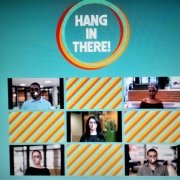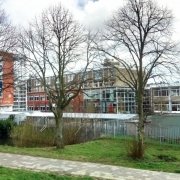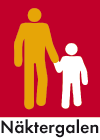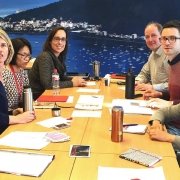EAFIT Children’s University
Excerpt
EAFIT Children’s University (ECU) is a social responsibility program at Universidad EAFIT for public engagement with science. It aims to communicate to people from all socio-economic backgrounds - not only scientific contents, but also how they are produced, how they relate to society and how society can participate in the development of scientific activities. It unfolds in three lines of action: inter-disciplinary science workshops and events, science communication contents and science education research. ECU promotes encounters between researchers, undergraduate students, children, youth, schoolteachers, and citizens in general.
Narrative, origins and objectives of the initiative
What kind of project is this? Please give a short description (summary) of it.
EAFIT Children’s University (ECU) is a social responsibility program at Universidad EAFIT for the public engagement with science. It aims to communicate to people from all socio-economic backgrounds - not only scientific contents, but also how they are produced, how they relate to society and how society can participate in the development of scientific activity. It unfolds in three lines of action: inter-disciplinary science workshops and events, science communication contents and science education research. ECU promotes encounters between researchers, undergraduate students, children, youth, schoolteachers, and citizens in general.
Please tell us why, in general, this project is considered a successful one?
Although ECU began its activities within the campus of EAFIT University, its evolution has allowed it to expand and become known in the field of education and communication of science. Thus, achievements are gratifying today, not only in terms of figures, but also in terms of experiences in social transformation. After that, the most outstanding ones are presented.
The program has shared experiences with numerous and diverse audiences
Regarding long-term science-based formative processes, the ECU has involved approximately 6.240 children and young people, 530 school teachers, 480 undergraduate students, 371 primary and secondary education institutions and 210 researchers. In addition, more than 21.000 people have participated in science events. ECU’s formative processes gather children, young people and schoolteachers from private and public schools, providing them an opportunity to recognize and value diversity in a city where these encounters are scarce and where there is a great gap between public and private sectors regarding education quality.
ECU’s methodology has been applied in diverse contexts:
Workshops conducted on campus have been a living lab, which have enabled ECU to apply its hands-on methodology off‑campus:
- in IBSME projects developed for and with the local and national government and the private sector, including a model of a city council with young people, inter-sectoral debate sessions to understand problems of national concern and school clubs for engagement with mathematics;
- designing and implementing in-territory community engagement strategies with researchers;
- promoting science during public events such as the Medellin Book Festival, the Medellin Science Fair and the Early Childhood Festival Buen Comienzo. The science content projects of ECU comprise radio broadcasts, an annual printed publication, science stories booklets, and manifestos by children, among others.
Likewise, the program has made visible the voices of children and young people, facilitating the construction of manifestos in events such as the “I Forum of Low Carbon Cities”, the “VII World Urban Forum”, the “Escuelas Vivas Comunitarias” event, “Children Have their Say - Congresito de la Lengua Española”, which was held within the framework of the International Congress of the Spanish Language in alliance with Cantoalegre, or the “6th Plenary Session of the Intergovernmental Science-Policy Platform on Biodiversity”.
In addition, ECU has organized events for citizens in general, such as the Science Project Symposiums, where young people publicly present their research proposals. Moreover, ECU has arranged theater plays (“Ventana al cielo”, about Galileo Galilei, and Socrates, “de los sueños de Violeta y las aventuras de Garabato”) and didactic concerts (“De Galileo a Darwin: diálogo de dos científicos en clave de sol” or “Cuatro Ojos Serieclub”, a club where children can talk about science and arts in audiovisual series).
The program has created alliances
One of the great achievements of the program has been to join the European Children's Universities Network (EUCU.NET) and to introduce ECU as a program that is permanent, that is structurally inserted into the research system of the EAFIT University and that conducts practice-based research. In the framework of the network, permanent dialogue with other universities, mainly in Europe and participation in congresses and meetings, as well as the exchange of experiences, has been possible. Likewise, belonging to the Latin American and Caribbean Network for the Popularization of Science and Technology (RedPOP - The Red de Popularización de la Ciencia y la Tecnología en América latina y el Caribe) allows the program to be in permanent contact with entities that share their missionary spirit.
Also, the program was recognized as an advisory to the SiS Catalyst project, an action plan of the European Commission to promote mutual learning and mobilization in children and young people.
Additionally, the program is a member of the Medellin Network for Research by School Students, the Good Start Inter-university Network, which promotes the development of public policies and strategies regarding early childhood well-being.
ECU’s work has been acknowledged in the region
ECU has been recognized in Colombia and Latin America by the Colombian Association for the Advancement of Science (2012) and the Latin American and Caribbean Network for the Popularization of Science and Technology (RedPOP) (2017) because of its engagement efforts, methodology transfer and knowledge exchange with national and international stakeholders. Thus, becoming a model of science education in Latin America. In 2018 ECU was in the lead at the Andean Node of RedPOP.
And why would you consider it a grass-roots initiative?
In 2004, before his flight back to Colombia from Madrid, Juan Luis Mejía, Universidad EAFIT’s chancellor since 2002, found a book titled The Children’s University, Scholars Explain the Mysteries of the World by Ulrich Janssen and Ulla Steuernagel. This is how he came to know the concept of Children’s University and the experience of the first one of them: Eberhard-Karls University in Tübingen, Germany. By that time, EAFIT was planning the celebration of its 45th anniversary in 2005 and, impressed by what he had read, he thought that something similar could be done at the campus to gather children and researchers. He shared this idea with the then Communication and Culture Department Director, Ana Cristina Abad Restrepo, who readily started working on the proposal along with an education team.
During the first year, 2005, ECU was rather a science-based marketing strategy mostly aimed at students from private schools. 200 children came to the campus once a month and participated in a workshop addressing a question selected from a focus group with children within the same age range. Every workshop was created along with an EAFIT researcher coming from a related academic field. The initiative was so successful that researchers, parents, children and schoolteachers from both participating and non-participating schools asked for continuity.
However, evaluation conducted by the ECU team, including the chancellor, led to a shift in strategy: ECU started being a social inclusion program in 2006. Since this year, a new criterion is established: one half of the participating schools must be public and the other half private. This measure is a way to tackle social fragmentation in a city with a Gini coefficient of 0,464 in 2017 and with a lower education quality in the public schools compared with the private ones; it promotes that children recognize contexts different from theirs and have the opportunity to discover the importance of diversity when working for common goals.
Since then, ECU has expanded its lines of action. Two additional phases were created in which children can continue a formative process. Educational innovation strategies have been implemented with schoolteachers and professors, science communication contents have been produced and a line in science education research is emerging.
Traditionally, universities in the region have created diverse strategies to engage children and young people in science such as science summer camps, hands-on science activities for high school seniors or science courses in specific fields. However, these initiatives are oriented towards either recruitment of undergraduate students or conceptual approach to scientific knowledge instead of development of both citizenship and scientific skills.
Unique about ECU is that it has become a program that not only bridges the gap between children and research, but also strengthens the relation between higher, secondary and primary education. Additionally, ECU provides Universidad EAFIT insights into diverse social contexts and is its representative in social discussions about childhood and education.
What challenges needed to be solved in this project?
The project has faced a number of challenges during its implementation and development related to:
Didactic transposition: These challenges have to do with the design of experiences to promote a bi-directional relationship between the actors, results and production dynamics of scientific knowledge and society - more specifically, with how to facilitate closeness to scientific concepts among children and young people. In response to this kind of challenges, ECU has established four methodological principles on which all activities are based. One of them is play, conceived as a strategy to interact with other people, bring about joy, and facilitate access to new ideas. Another principle is experience, that is, workshops must include experiments and hands-on activities to allow children and young people to have a firsthand approach to knowledge. Additionally, there is conversation, which allows to recognize the ideas of others, reach consensus, and identify dissents. Finally, there are questions, which are used to encourage interest in those things that might seem obvious and promote critical thinking.
Researcher’s involvement: One of the key features of children’s universities is that they promote the face-to-face meeting between researchers and children. This feature entails challenges such as those related to institutional support and conceptual advisory. Regarding the first one, a facilitating factor has been that EAFIT allocates the time invested by researchers in ECU activities as a fraction of their workload and department heads are plenty aware that ECU is a mission of EAFIT. Considering conceptual advisory, a protocol has been created, so it is clear for researchers what the workflow is when they become co-designers and advisors. This protocol includes the writing of a conceptual guidance document, participation in study and design meetings along with workshop designers and facilitators and personal meetings with children and youth.
The training of workshop facilitators has been another challenge to face, because EAFIT does not have any program related to education sciences. To overcome this challenge, ECU has resorted to the advisory of pedagogy professionals and included a psychology professional in its team. This has contributed to consolidate a formative process for workshop facilitators, which enables them to work with children and youth.
Is this initiative based on any particular theoretical framework? Which one?
ECU is based on a theoretical framework that gathers diverse, yet complementing, references in education sciences. It includes elements such as Intellectual Joy by Jorge Wagensberg (2007), question hermeneutics by Hans-George Gadamer (2008), Richard Feynman's conception of science (1997), the theory of multiple intelligences by Howard Gardner (2010), the constructivism of Jean Piaget (2013) and Philosophy for Children by Matthew Lipman (2002), among others.
(Appendix) Is your intervention standing on its own or is it a part of a bigger and more holistic approach?
Please describe the group(s) intended as beneficiaries of this initiative
Why has this group (have these groups) been chosen?
At the beginning of the 21st century, Universidad EAFIT had a special interest in opening its gates to the public other than high school and college graduates, in line with both the understanding that universities must strengthen their relationship with schools and society and the lifelong learning policies adopted abroad. In this sense, “Saberes de vida” and ECU were founded; with the former being a continuing education program for adults and ECU a program to engage children and youth in science.
Once ECU came into being, researchers also became a target group, since ECU was highly regarded because of its expertise in science communication for children and youth. On this regard it represented a way to channel their outreach-related motives of these researchers.
Later, given the interest of some schoolteachers in ECU’s methodology as good practice in education and the ambition in the side of EAFIT in strengthening ties with schools and in consolidating itself as a learning-centered university, ECU started diversifying strategies specifically tailored for them as well as for university professors.
Could you please tell us something about the relative size of the (of each) target group, within the school/university population, region and/or country?
In 13 years, ECU has reached the following:
- Over 6.200 school children and young people of a total population of approx. 350.000 pupils in primary, lower and upper secondary school
- 530 schoolteachers, out of 10 000 in the region
- 371 primary and secondary schools, out of 550 in the region.
- 480 undergraduate students out of an average annually student population of 10.000.
- 300 researchers out of a research staff of 1.000.
Which social characteristics are taken into account and what is the geographical area covered?
Places at ECU are allocated to schools in the Metropolitan Area of the Aburrá Valley. This is done to ensure that half of them are assigned to public schools and the other half to private ones. The nature of schools, in our context, is correlated with socio-economic levels; children from high socioeconomic levels tend to enroll in private schools and those from lower socio-economic levels in public ones.
On which level is the project implemented?
Please describe the political and socio-economic factors that you believe have been important enablers for your initiative
Did the initiative have political support?
No. However, local and national government have chosen ECU to operate some of their science communication and citizen engagement projects.
How did it fit with local, regional or national policies?
ECU is in line with national policies such as Statute 1286 (2009), Social Appropriation of Science and Technology Policy (2005), and the Strategy of Social Appropriation of Science and Technology (2010). Additionally, it is in accordance with the Municipal Science, Technology and Innovation Plan for 2011-2021 and is one of the key elements of the EAFIT’s 2012-2018 development plan. All these policies aim at social engagement with science, technology and innovation as a way to strengthen governance and legitimacy in strategies for social and economic development.
Who are the stakeholders supporting the initiative?
EAFIT Directive Board and research community
Are there particular demographic changes present that are influencing the project?
No particular demographic changes are currently influencing the project
What is the institutional strategy and culture of the (educational) organization?
Universidad EAFIT’s mission is to contribute to the country’s social, economic, scientific, and cultural development through programs that educate globally competent individuals within a framework of ideological pluralism and academic excellence, as well as through scientific and applied research conducted in permanent interaction with the private sector, government and academia.
To what extent does the initiative have an influence on institutional policy (or potential influence) of the (educational) organization?
ECU is regarded by EAFIT as a consultant in the field of science engagement; in this sense, the program has a real incidence in the policy discussions.
Moreover, ECU coordinates the Andean Node of the Latin American and Caribbean Network for the Popularization of Science and Technology. In this way, it has a voice regarding the policies of this organization. Additionally, it belongs to the Medellin Inter-University Early Childhood Network, which may advise local government with respect to early childhood policies.
(Appendix) Is there public support for your initiative and the issue it addresses?
(Appendix) What other factors do you think have been important for the success of this initiative?
Please describe the overall initiative design and the methods and tools used to reach the goals
Please describe the specific activities carried out.
ECU develops science workshops (for children, youth, schoolteachers, professors and science communicators), children manifestos, radio podcasts, videos, a science communication magazine and research projects on science communication within an over-arching and integrated cross-cutting institutional approach of policy, strategy and practice.
What were the key roles (teacher, student, management team etc.) within the project?
Schoolteachers, school students, professors, researchers, undergraduate students, EAFIT’s management staff, ECU professional team, and pedagogical advisors.
What ideas, tools, theories, models, methodology (etc.) have been used to reach the goals?
Throughout these years, ECU was nurtured from several movements and pedagogical practices:
Waldorf pedagogy (Rudolf Steiner)
- This program recognizes the seven-year periods, or stages of development, proposed by this concept and adapts its pedagogical practice to the characteristics of each of them.
- The activities of the workshops guide the participants to relate their new learnings with previous experiences.
- Play is present as a mode of expressing character of childhood and as a way of learning.
- Stories, and in general narrative structures, are used to nourish the child's imagination.
- Two elements present in the Waldorf schools are taken: the circle, as a form of frequent spatial organization, and the logbook, which is used to leave traces of the process experienced by the participants (drawings, experiences, team work, carrying out missions).
Constructivism (Jean Piaget)
- ECU encourages the child or young person to interact with the objects of knowledge, seeking while this interaction is carried out with other participants and with the workshop participants.
- In the workshops, the subject has an active role in the construction of knowledge.
- The activities seek to make the learning meaningful for the subject, that is, that the new information is related to the knowledge he already possessed.
Multiple intelligence (Howard Gardner)
- To stimulate the development of the seven types of intelligence proposed by Howard Gardner (linguistic, logical-mathematical, spatial, musical, corporal and kinetic, intra-personal, interpersonal) different types of activities are carried out: creative, artistic, corporal, logical math, writing, reflective, individual and group. This range of activities seeks that children and young people discover and strengthen their interests and abilities and be recognized for their talents and abilities.
- In workshops, it is intended that the participants do not stay in the informative dimension and reach the comprehension.
- The topics and questions are addressed from five access points, which appear throughout the workshops:
- Narrative: story or narration.
- Logical-quantitative: numerical questions or processes of deductive reasoning.
- Philosophical: fundamental and terminological facets of a concept.
- Aesthetic: sensory traits and artistic postures.
- Experimental: hands to the mass, work with materials.
Music and movement in education (Karl Orff)
- In ECU’s workshops, music is present as a form of expression: groups sing, play and dance, creating an effective climate that brings together and entertains.
- Experimentation is used through the senses and movement, as a source of knowledge.
- Improvisation and creation are present in the workshops: the possibilities of a material are explored and then something is created from it.
- In activities with children and young people, the experience and practical work are put in the foreground: the participant hears, looks, feels, feels, plays, and is involved in the processes physically, emotionally and intellectually.
Intellectual Joy (Jorge Wagensberg)
- The activities are designed so that participants enjoy the learning process.
- In the workshops, stimuli are offered to arouse curiosity and move the children towards a question.
- Conversation spaces are offered as a pre-comprehension phase.
- In activities with children and young people, sensory experiences are provided as ways to relate to reality and stimulate questions.
What are the final revenues of the project?
Please describe if your project ensured its sustainability
If so, how did you ensure the short-term impact of the project?
In terms of sustainability of the school and academic community as well as transfer of knowledge and tools to other contexts, ECU has a special interest in working with educational process mediators, such as schoolteachers, EAFIT professors and researchers. Therefore, the training strategy for mediators is another program component on a permanent basis, which is expected to impact other contexts and audiences.
Additionally, ECU’s staff (university students) participate in pedagogical and group management training that leads them to later engagement in educational programs, regardless of their prior training, as evidenced by ongoing research.
On the other hand, there is an impact of the program within the university, which was recently evidenced by the interest of the researchers in actively involving the communities in the areas of influence of their research projects, with which they have found in the ECU an ally and vehicle to achieve this.
And how did you ensure the long-term impact of the project?
Has your project been replicated elsewhere?
Please tell us about the resources used in this initiative
What was the budget for the initiative?
EAFIT Children’s University has an annual budget of approx. 300.000 EUR, which allows it to impact more than 650 children and young people, 60 school teachers, 70 university students and 25 researchers annually.
ECU is considered part of the corporate social responsibility agenda of EAFIT, and therefore 98% of its budget comes from the university. However, the last stage of the programme, which is aimed at young people of the last school grades, charges fees for participants from higher socio-economic strata, which subsidizes the participation of those who cannot afford these costs. This income allows paying the basic expenses of this program stage and does not represent any profit for the university.
On the other hand, projects carried out outside the program stages are financed by contracting entities (companies, foundations or public sector) or are carried out in partnership with other entities.
How much did the initiative depend on volunteers?
Approximately 40% of the workshop facilitators (undergraduate students) are volunteers of the program who have an interest in working with children and young people or who wish to strengthen personal skills, as mediators of communication processes and science education.
How were the costs perceived by the public/the sector/other stakeholders?
To what extent did the initiative achieve its objectives?
Please describe the evidence to support the success of your initiative.
The program conducts periodic evaluations to assess the results of the program in the learning process of the participants, considering the development of social, communicative and scientific skills in children and young people. For school teachers, ECU evaluates how they recognize tools to innovate classroom teaching and carry out changes in their practice.
These evaluations, mostly qualitative, highlight a strengthening in the participants' ability to formulate pertinent questions around a given topic, argue their ideas and assess the diversity of views in a group. These skills are also highlighted when these participants are invited to participate in other strategies of knowledge appropriation, such as the city manifestos, where their participation is active, informed and diverse.
For teachers, the evaluations show that they value the possibility that ECU offers them to reflect on their practice, exchange experiences and dare to innovate in their teaching and learning methodologies.
Did the intervention lead to any unintended (positive) outcomes?
What indicators (quantitative and qualitative) have you measured to demonstrate success?
(Appendix) How did you evaluate/monitor this intervention?
In addition to the periodic evaluations carried out by the program, research is carried out to evaluate the program's impact on different aspects, in alliance with EAFIT Psychology Department. The following investigations are highlighted: the influence of the program on the vocation of the workshop participants and the impact of the methodology on the fluid intelligence of the participants, with respect to a control group, using a common standardized test in psychology research cognitive (G Factor test).

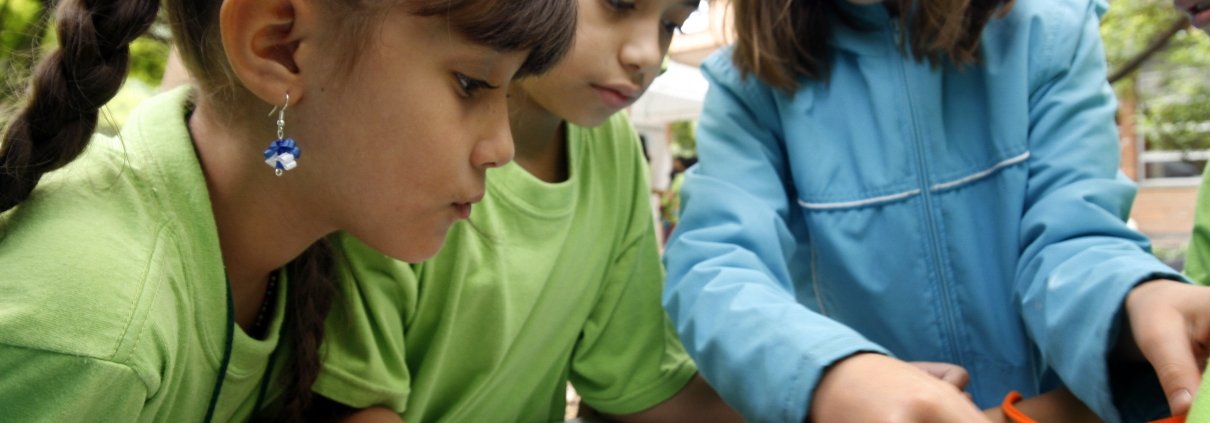 Robinson Henao
Robinson Henao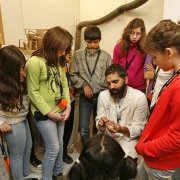
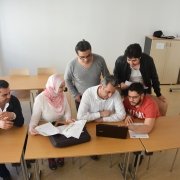 Copyright: Camilla Pellech, Postgraduate Center der Universität
Copyright: Camilla Pellech, Postgraduate Center der Universität